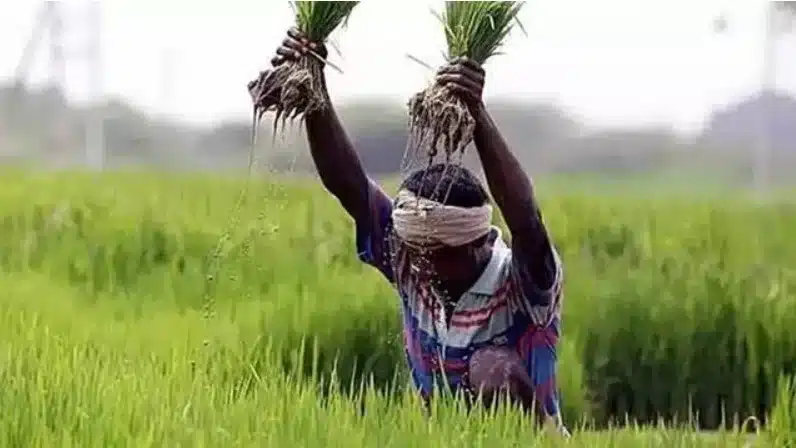What’s in today’s article?
- Why in news?
- What is Pradhan Mantri Fasal Bima Yojana (PMFBY)?
- What are the key features of the PMFBY?
- News Summary: Pradhan Mantri Fasal Bima Yojana (PMFBY) finds more takers
- Key highlights
Why in news?
- The insured gross cropped area of non-loanee farmers under Pradhan Mantri Fasal Bima Yojana (PMFBY) has reached a new high.
- This indicates growing acceptance of the Centre’s crop insurance scheme.
Pradhan Mantri Fasal Bima Yojana (PMFBY)
- About:
- A scheme of the Ministry of Agriculture & Farmers Welfare, PMFBY is an insurance service for farmers for their yields, launched in 2016.
- The new Crop Insurance Scheme is in line with the One Nation One Scheme theme.
- The PMFBY replaced the previous two schemes: the National Agricultural Insurance Scheme (NAIS) and the Modified NAIS.
- Objectives:
- To provide insurance coverage and financial support to the farmers in the event of failure of any of the notified crops as a result of natural calamities, pests and diseases.
- To stabilise the income of farmers to ensure their continuance in farming.
- To encourage farmers to adopt innovative and modern agricultural practices.
- To ensure flow of credit to the agriculture sector.
Key features of the PMFBY
- Premium rates
- There will be a uniform premium of only 2% to be paid by farmers for all Kharif crops and 1.5% for all Rabi crops (winter sown).
- In case of annual commercial and horticultural crops, the premium to be paid by farmers will be only 5%.
- The balance premium will be paid by the Government (to be shared equally by central and state government).
- The idea is to provide a fully insured amount to the farmers against crop loss on account of natural calamities.
- Area based approach
- The Scheme will be implemented on an ‘Area Approach basis,’ i.e., Defined Areas for each notified crop for widespread calamities,
- The unit of insurance shall be Village/Village Panchayat level for major crops and for other crops it may be a unit of size above the level of Village/Village Panchayat.
- It is assumed that all insured farmers in a unit of insurance, to be defined as a “Notified Area” for a crop, face similar risk exposures.
- No upper limit to subsidy
- There is no upper limit on Government subsidy. This means, even if the balance premium is 90%, it will be borne by the Government.
- Use of technology
- Crop Insurance App: Provides for easy enrollment of farmers. It facilitate easier reporting of crop loss within 72 hours of occurrence of any event.
- Latest Technological Tools: To assess crop losses, satellite imagery, remote-sensing technology, drones, artificial intelligence and machine learning are used.
- PMFBY Portal: For integration of land records.
- Exemptions from tax liabilities
- There will be exemption from Service Tax liability of all the services involved in the implementation of the scheme.
- Beneficiaries to be covered
- All farmers growing notified crops in a notified area during the season who have insurable interest in the crop are eligible.
- To address the demand of farmers, the scheme has been made voluntary for all farmers from Kharif 2020.
- Earlier, the enrolment was compulsory for farmers who possess a Crop Loan account or Kisan Credit Card (KCC) account, etc).
- Risks covered under the scheme:
- Comprehensive risk insurance is provided to cover yield losses due to non-preventable risks, such as Natural Fire and Lightning, Storm, Hailstorm, Cyclone, Typhoon, Tempest, Hurricane, Tornado.
- Risks due to Flood, Inundation and Landslide, Drought, Dry spells, Pests and Diseases will also be covered.
- In cases where the majority of insured farmers in a notified area have intent to sow or plant and have incurred expenditure for the purpose, but are prevented from sowing or planting the insured crop due to adverse weather conditions, indemnity claims up to a maximum of 25% of the sum-insured may be made.
- In post-harvest losses, coverage will be available up to a maximum period of 14 days from harvesting for those crops which are kept in “cut & spread” condition to dry in the field.
- Loss and damage resulting from occurrence of identified localised risks like hailstorm, landslide and Inundation affecting isolated farms in the notified area would also be covered.
News Summary: Pradhan Mantri Fasal Bima Yojana (PMFBY) finds more takers
- More non-loanee farmers are now covered under PMFBY, showing increased approval of the government’s crop insurance program.
- Non-loanee farmers are those farmers that have not taken any loan from bank or other financial institutions.
Key highlights
- Jump in non-loanee area
- The non-loanee area has jumped to 180 lakh hectares during crop year 2022-23 under the PMFBY.
- This is 70 per cent higher as compared to 106 lakh hectares during 2021-22.
- The insured non-loanee area accounted for 36.07 per cent of the total insured area under the PMFBY during 2022-23.
- Loanee area has seen a decline
- The loanee area has seen a decline from 444 lakh hectares in 2019-20 to 320 lakh hectares in 2022-23.
- Reason for this decline in the loanee area.
- Initially, the scheme was compulsory for loanee farmers, who possess a crop loan account/Kisan Credit Card (KCC) account to whom credit limit is sanctioned/renewed for the notified crop during the crop season.
- However, from Kharif 2020, it was made voluntarily.
Q1) What is Kisan Credit Card (KCC)?
The KCC Scheme was introduced with the objective of providing adequate and timely credit to the farmers for their agricultural operations. The Government of India provides interest subvention of 2% and Prompt Repayment Incentive of 3% to the farmers, thus making the credit available at a very subsidized rate of 4% per annum.
Q2) What is National Agricultural Insurance Scheme (NAIS)?
National Agricultural Insurance Scheme (NAIS) was introduced by the Government of India to provide insurance coverage and financial subsidy to the farmers in the event of crop losses suffered on account of natural calamities, pests and diseases.
Source: Centre’s crop insurance scheme finds more takers | Vikaspedia
Last updated on June, 2025
→ UPSC Notification 2025 was released on 22nd January 2025.
→ UPSC Prelims Result 2025 will be out soon for the CSE held on 25 May 2025.
→ UPSC Prelims Question Paper 2025 and Unofficial Prelims Answer Key 2025 are available now.
→ UPSC Calendar 2026 is released on 15th May, 2025.
→ The UPSC Vacancy 2025 were released 1129, out of which 979 were for UPSC CSE and remaining 150 are for UPSC IFoS.
→ UPSC Mains 2025 will be conducted on 22nd August 2025.
→ UPSC Prelims 2026 will be conducted on 24th May, 2026 & UPSC Mains 2026 will be conducted on 21st August 2026.
→ The UPSC Selection Process is of 3 stages-Prelims, Mains and Interview.
→ UPSC Result 2024 is released with latest UPSC Marksheet 2024. Check Now!
→ UPSC Toppers List 2024 is released now. Shakti Dubey is UPSC AIR 1 2024 Topper.
→ Also check Best IAS Coaching in Delhi






















